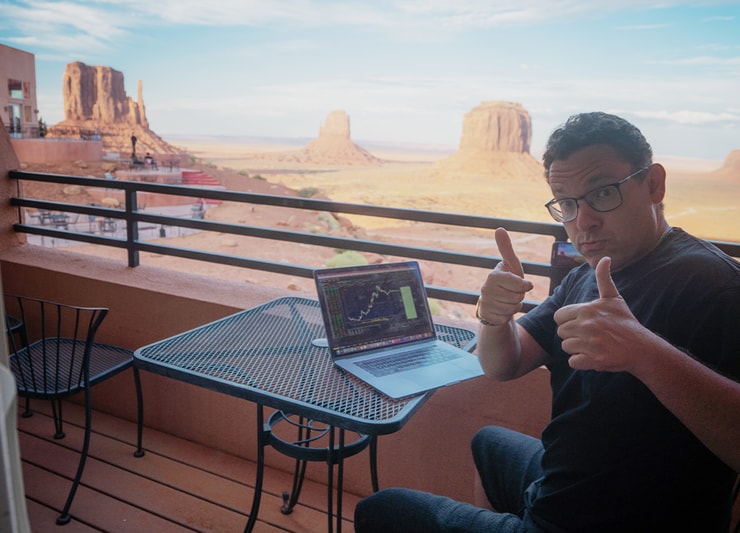Very few things feel worse than seeing a trade you’re up in…all of a sudden turn sour.
Have you ever caught yourself staring at the screen, praying for a turnaround, even when all signs scream… GET OUT?
I’ve been there. It’s a silent battle between hope and reality, and it can obliterate not just your account but also your spirit.
But what if there were clear signs to guide your exit?
A lifeline amid the chaos?
Settle in because I’m about to share the four undeniable signs that it’s time to cut your losses (or take your profits), ensuring you trade smarter, not harder.
Table of Contents
Trading Shouldn’t Be Stressful
You will feel the heat when you rush trades, come unprepared, and overleverage.
But let’s talk about when things aren’t going your way…and when it’s time to bail out of a trade.
#1 Price Action Weakens
If you’ve been reading my blog, then you already know that I primarily take long positions.
My favorite pattern to trade has been dip-buying heavily shorted penny stocks.
But before I get into any trade, I have a plan.
Markets heating up! Good time to start. https://t.co/bYs48vLSPm
— DanPJ76 (@DanPj76) August 31, 2023
If I’m buying something, then I want it to go up, right?
If it doesn’t right away, that means my thesis is wrong.
That’s why I don’t hesitate to cut losses quickly.
But I’m also bailing on a trade if it stalls too.
Some traders will wait for a position to go red on them. But if I’m aiming for a quick spike up, and it isn’t happening…then I’m wrong. I don’t need the stock to move against me to exit.
You don’t want to be a bag holder.
If the price action weakens, don’t be someone who hopes and prays things turn around.
One thing I’ll do is jump into a stock more than once. Why stay in it if I think it is weak when I can sit on the sidelines and get a better entry later?
It’s not uncommon for me to trade the same symbol 2 or 3 times in one day.
More Breaking News
- Why SoFi Stock is On the Rise
- Should You Buy First Majestic Silver Corp. Now?
- SCAG Stock’s Rollercoaster: What’s Next?
Pay attention to the price action. It can help you realize a shift is occurring before the price drops.
#2 Change In Stock Volume

2025 Millionaire Media, LLCHow often have we seen a stock pop hard in the pre-market, only to fade once the market opened?
It seems like it happens every Friday, right?
On the other hand, the best plays often churn like crazy…with the volume trading the float several times over.
When the volume dries up, spreads can widen, and more importantly, it’s easier for the stock to sell off sharply on just a few orders.
If you’re like me, you need momentum for quick profits.
#3 Breaking of Key Support or Resistance Levels

2025 Millionaire Media, LLCWhile I don’t swing trade and primarily focus on quick-day trades, that doesn’t mean I ignore a stock’s history.
I often look at daily, weekly, and monthly charts.
Why?
Because I want to know where long-term support and resistance levels are.
I want to know where the buyers are and where we might start to see selling pressure.
With that in mind, I don’t necessarily get out at whole numbers or exactly when support or resistance is broken.
Why?
Because I know algorithmic traders are trying to take advantage of newbies…
They know where they set their stops…
So it’s easy to flush a stock down, get all the longs out, and then spike the stock back up.
And that’s what I’m looking for when I’m panic dip buying.
#4 The Fundamentals Shift
Last week, NAOV was trending so nicely…
Each dip created a buying opportunity.
However, late in the afternoon, the stock cracked.
But I didn’t care to dip buy it again.
Why?
Because the fundamentals changed.
The company announced a $5 million private placement.
The same thing happened in ADTX last Thursday.
It went from $20 to $83…
But when it announced a $10 million private placement…the play was more or less over.
That’s why you must be keeping up with the latest news.
When the fundamentals shift, be ready to exit.
What’s Your Next Play?

2025 Millionaire Media, LLCIf you struggle with exiting bad trades, start making a trading plan and learn how to stick to it.
Trading isn’t about winning or losing.
It’s about making money.
Stop trying to be right all the time.
If you’re looking for ways to take to level up, then I’ve got something for you.
Every day, my team and I host live training classes.
In these training sessions, we talk about the hottest moving stocks, market psychology, and the latest trends we see working.
Best of all, we bring them to you at zero cost.
They are spread out throughout the day, so I’m confident there’s a time slot that fits your schedule.







Leave a reply